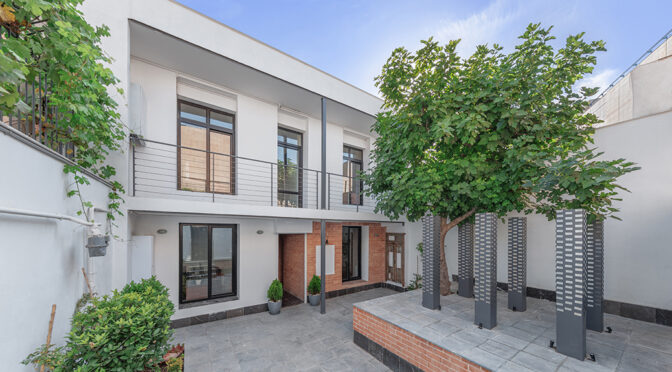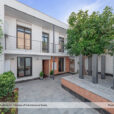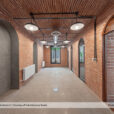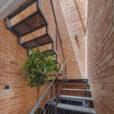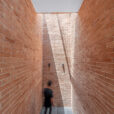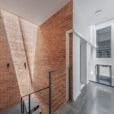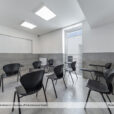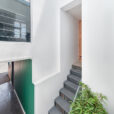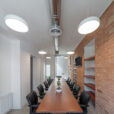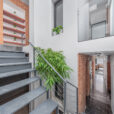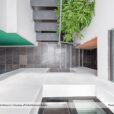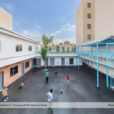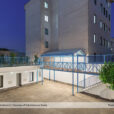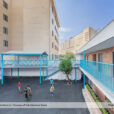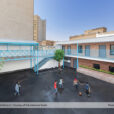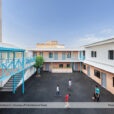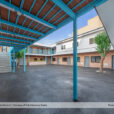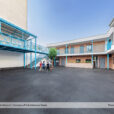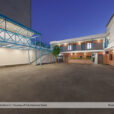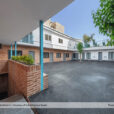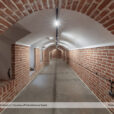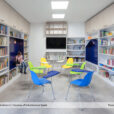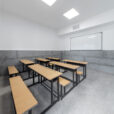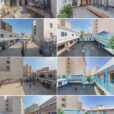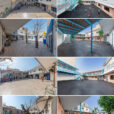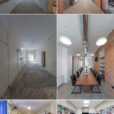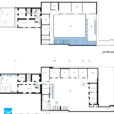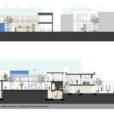مدرسه انجمن روشنگران فردای کودک (ارفک)
استودیو معماری شماره چهار (محمدیوسف صالحی، محمدصادق افشارطاهری، کسری شفیعیزاده)
موقعیت: تهران، ایران
تاریخ: ۱۳۹۹
مساحت: ۸۰۰ مترمربع
وضعیت: ساختهشده
کارفرما: بچههای ارفک
تیم طراحی: آذین ساوهدرودی، ایمان اسلامی، ثمین حیدری، فرشید نصر آزادانی، موژان فکری، هلیا مرادزاده، بردیا شفیعیزاده، آرزو حکمت، محیا عموئی، آرش فقیهی
سرپرست پروژه: احمد علیپور، محمد کدرانی
سازه: ایمان حضرتی
اجرا: استودیو معماری شماره چهار
عکس: پیمان امیرغیاثوند
در پروژه ارفک که مدرسهای مربوط به آموزش کودکان کمبرخوردار (کودکان کار) بود، کارفرمایی وجود نداشت. عدهای همدل و همفکر برای دستیابی به آرزویی بزرگ جمع شده بودیم. قرار بود ساختمان قدیمی مدرسه برای گسترش فضاها و ارتقاء سطح کیفی، به ساختمان قدیمی دیگری در پشت مدرسه الحاق شود، و همچنین دستی به سر و گوش مدرسه بکشیم. هدف این بود که با هزینه کم، فضایی ارزشمندتر برای کودکان درست کنیم، و باید به گونهای عمل میشد که اختلالی در کارکرد مدرسه ایجاد نشود، و بودجه اجرای پروژه نیز به صورت برنامهریزی شده و مرحلهای از خیرین جمع شود که اینها چالشهای بزرگی برای پروژه بودند.
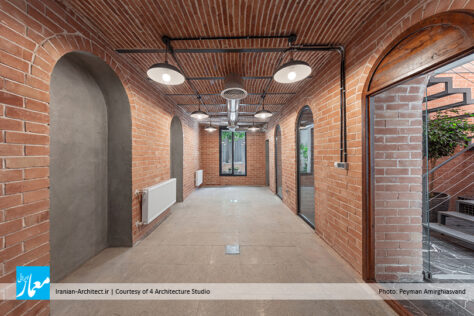
ما کار را با زدودن اضافات از دو ساختمان بهظاهر کمارزش موجود شروع کردیم. هر چه پیش میرفتیم، متوجه ارزش هر دو ساختمان میشدیم؛ دالانها و طاقهای دفنشده یکییکی پیدا میشدند و کل طرح را بار دیگر تغییر میدادند. در طراحی این پروژه سعی بر حفظ هویت و بازنمایی آن داشتیم؛ تمامی حفرهها و طاقها و الگوها مستحکم میشدند و از ظاهر آنها به عنوان المان طراحی استفاده میشد. در واقع، حس خانه گمشده در این ساختمانها را دوباره نمایان کردیم. سازه نیز به دلیل قدمت بالای ساختمانها، تقویت، و سیستم گرمایش و سرمایش مناسب به پروژه افزوده شد.
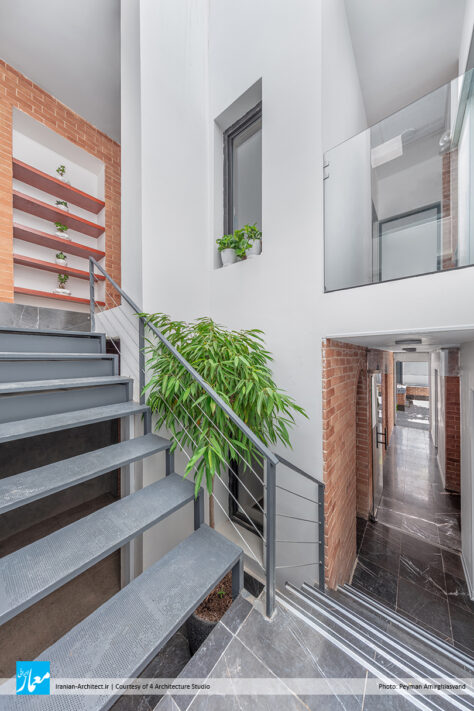
برای استفاده از رنگها، مصالح و گیاهان، و نیز ارتباط بین فضاها، و نحوه ارتباط بین خیرین و کودکان و خدمه، با متخصصین مشورت شد، و فضاها با دقت و حساسیت بسیار طراحی شدند. در طراحی اولیه نیز افزودن فضاهایی چون کارگاه آموزشی، اتاق فکر، اتاق مشاوره، اتاق بازی، اتاق بهداشت و …، در اولویت قرار گرفت، و یک پل برای ارتباط بین فضاها تعریف شد که هم مسیر گذر ماجراجویی بچهها، و هم فضایی آموزشی و تفریحی باشد. همچنین عنصر بازی در گوشهکنار فضاها گنجانده شد، به گونهای که کودکان با حرکت در فضاها، به بازیگوشی، و کشف فضاها و پرسهزنی دعوت میشوند تا ذهن و روحشان برای مقابله با مشکلات پیش رو و موفقیتهای آینده قوی شود.
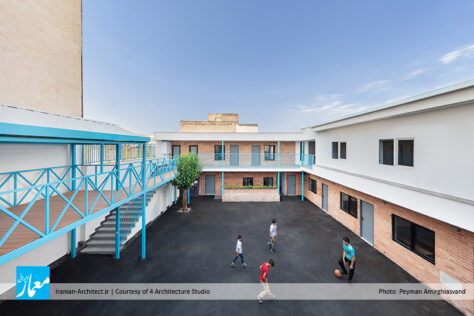
با توجه به ارتباط موضوع پروژه با فعالیتهای خیریه، فضایی با نام مهریاد تعریف شد تا دو بال گیرنده و بخشنده، با هم سخاوت خداوند را شکرگزار باشند، و نام مهربانان و گیرندگان مهر در کنار هم و بدون تفکیک قرار بگیرند. ما نیز با توجه به مسئولیت اجتماعیمان، تصمیم گرفتیم که این پروژه را به صورت خیرخواهانه طراحی و اجرا کنیم.
Arfak NGO School
4 Architecture Studio (Mohammad Yousef Salehi, Mohammad Sadegh Afshar Taheri, Kasra Shafieezadeh)
Location: Tehran, Iran
Date: 2020
Area: 800 sqm
Status: Completed
Client: Children of Arfak NGO
Design Team: Azin Savehdoroudi, Iman Eslami, Samin Heidari, Farshid Nasr Azadani, Mojan Fekri, Helia Moradzadeh, Bardia Shafieezadeh, Arezoo Hekmat, Mahya Amouei, Arash Faghihi
Project Manager: Ahmad Alipour, Mohammad Kadrani
Structure Consultant: Iman Hazrati
Construction: 4 Architecture Studio
Photo: Peyman Amirghiasvand
Arfak is school for low-income children (child labor), and there was no employer in this project. We were some empathetic and sympathetic individuals who gathered to attain a big wish. The old school building was to be appended to another building at the back of the school, to expand spaces and promote quantitative level, and also, we wanted to reconstruct the school. The aim was to make valuable space for children at a low cost. It should be done so that no interruption happened in school function, and also, the budget of implementing project should be collected in a planned and staged manner from donors; These were significant challenges for the project.
We started work by removing additions from the two seemingly low-value buildings. As we went along, we realized the value of the two buildings. Buried corridors and arches were found one by one, changing the whole design again. In designing this project, we tried to preserve identity and display it, and all holes, arches and patterns were strengthened, and their appearance was used as a design element. We represent the feeling of the lost house in these buildings. Since the buildings were very old, the construction was strengthened, and a suitable heating and cooling system was added to the project.
We consulted with experts for the use of colors, materials, plants, the connection between spaces, the relation between donors and children and crew, and design was done very accurately and sensitively. In the design phase, adding spaces like training workshop, think tank, game room, health room, and …, was prioritized. Also, for connecting spaces, a bridge was defined as a passageway for children’s adventure, and educational and recreational space. The game element was included in the corners of spaces, and children are invited to caper and discover spaces, and rove through movement in spaces, so that their minds and spirit become stronger for encountering problems and future successes.
Considering the subject of the project, a space named Mehryad was defined so that the two wings (receiver and giver) would be thankful to God for his generosity, and names of kind people and receivers of kindness would be beside each other without separation. According to our social responsibility, this project was decided to be designed and constructed in a philanthropic manner.

